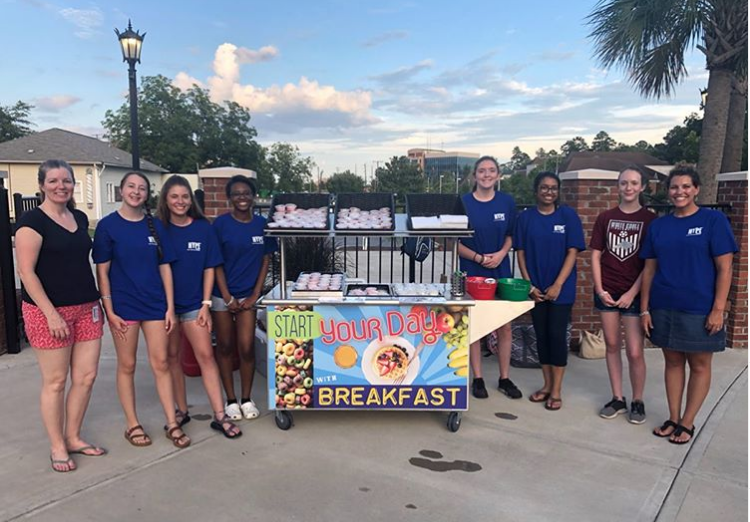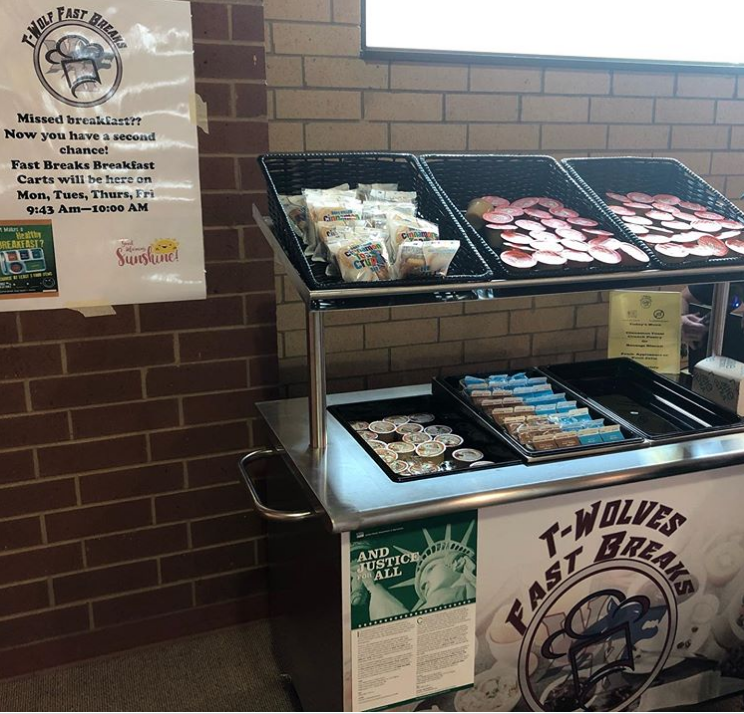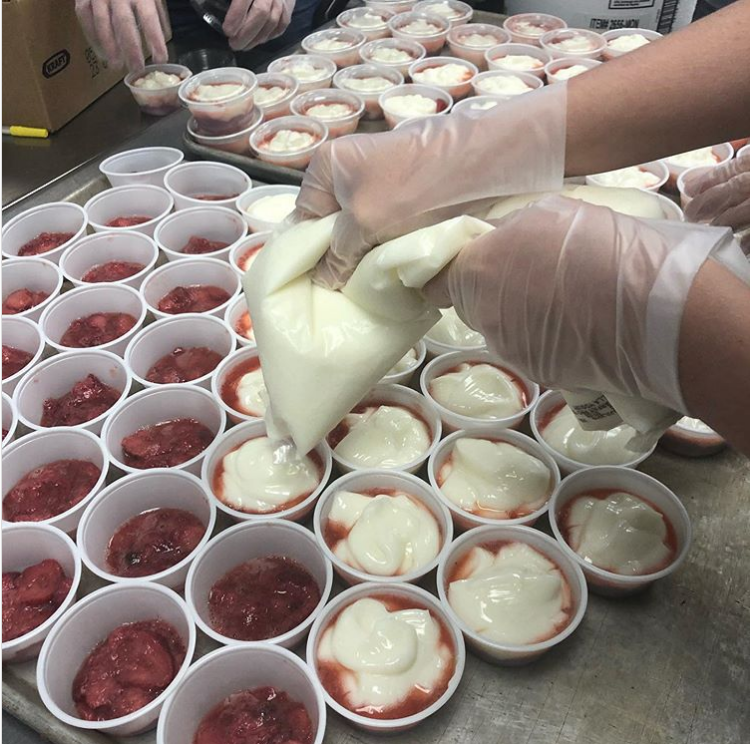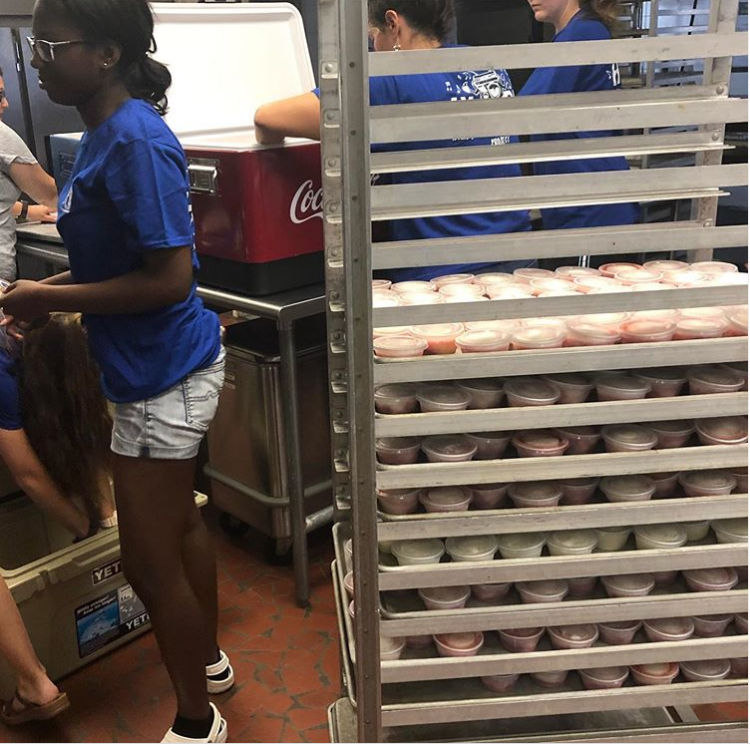 How do you serve breakfast to students when the campus is large and spread out and breakfast in the cafeteria just isn’t cool? You take the food to the students. That’s what students involved in The HYPE Project, teachers, and cafeteria staff did during the 2019-2020 school year with a Let’sGo! 3.0 mini-grant from Eat Smart Move More South Carolina.
How do you serve breakfast to students when the campus is large and spread out and breakfast in the cafeteria just isn’t cool? You take the food to the students. That’s what students involved in The HYPE Project, teachers, and cafeteria staff did during the 2019-2020 school year with a Let’sGo! 3.0 mini-grant from Eat Smart Move More South Carolina.
According to nationwide studies, breakfast participation is a struggle at many schools, and White Knoll High School is no different. At the beginning of the 2019-2020 school year, only 7% (140 students) of the student population (2,000 students) ate breakfast at school. Why?
- Students arrive late and miss the breakfast window.
- Students aren’t hungry at 7:30 in the morning.
- Students are social and prefer to meet up with friends.
- There is a stigma associated with eating breakfast at school.
- The campus is large and spread out, so the cafeteria is out of the way.
“Students need well-rounded, nutritious meals to get them to the lunch hour, and that can be pretty late in the day for some students,” says Kelly Blevins, food service manager at White Knoll High School. “Sure, White Knoll has vending machines, but we all know they don’t have the healthiest choices.”
The consequences of going hungry in the morning or choosing sugary or salty vending machine food and beverages equal poor classroom performance, poor test scores, and poor behavior. By eating breakfast, those indicators can be easily turned around.
Second Chance Breakfast, aka Fast Break
 Second Chance Breakfast is a nationally tested and proven program that offers a breakfast break in the morning, often after first period for older students in secondary schools. Food carts are strategically placed throughout the school stocked with healthy breakfast options for students, faculty, and staff to purchase by swiping their student ID card. Blevins heard about the program from Lexington School District One leadership and thought it would be worth the try.
Second Chance Breakfast is a nationally tested and proven program that offers a breakfast break in the morning, often after first period for older students in secondary schools. Food carts are strategically placed throughout the school stocked with healthy breakfast options for students, faculty, and staff to purchase by swiping their student ID card. Blevins heard about the program from Lexington School District One leadership and thought it would be worth the try.
With district leadership on board, Blevins needed to get support from faculty and staff, which she did; however, the most important stakeholders she needed approval and support from were the students. Enter Public Health Teacher Amber Morris, MPH, and her public health students.
Center for Public Health and Advanced Medical Studies
Lexington School District One provides students with opportunities to prepare for careers in specific areas through the Centers for Advanced Study. Located at White Knoll High School, the Center for Public Health and Advanced Medical Studies is a three-year, six-semester program in which students spend two blocks each semester of their sophomore through senior years exploring public health and medicine.
Teacher Amber Morris, MPH, is actively involved in the public health profession. Through her contacts, she learned about the Eat Smart Move More Lexington County chapter. At a meeting, she learned about The HYPE Project and the Let’sGo! 3.0 mini-grant opportunity, so she applied to fund a HYPE team. After learning about the Second Chance Breakfast program from Blevins, the two teamed up with public health students to plan and launch the Fast Break program at White Knoll High School.
“When Amber came to me and told me that her students wanted to help us, I was excited. It was great to see that these girls knew and understood that nutrition is one of the most basic things you need to cover and so they helped make it their own, which is great,” says Blevins.
Blevins had already purchased four food carts, so the HYPE team decided to use part of their mini-grant funding to purchase a fifth cart, which meant more access to the stations and more students served.
“Our latest lunch is at 1:30 p.m., so if you can’t have breakfast in the mornings, you’re probably going to be pretty hungry by the time lunch comes around,” says Zoe, a 17-year-old student and HYPE team member. “So, we wanted to provide for those students who got there a little later or who weren’t hungry at 7:30 in the morning.”
Blevins also teamed up with the digital arts classes for logo and food cart graphics design. “It was incredibly important to me to let these kids know the program is for them. Their teacher was so wonderful to help us out. It didn’t seem like too big of an ask. They created the Fast Break logo and the vinyl wrap for the carts.”
Youth Voice is Powerful
 If breakfast isn’t cool in the minds of teenagers, how do you get them to even consider breakfast at school? You use your existing partnership with the HYPE team and the digital arts students to spread the word. The students took ownership of the Fast Break program.
If breakfast isn’t cool in the minds of teenagers, how do you get them to even consider breakfast at school? You use your existing partnership with the HYPE team and the digital arts students to spread the word. The students took ownership of the Fast Break program.
To get community and student buy-in, the HYPE team planned a taste test during the Town of Lexington’s Kids’ Day community event and at freshman orientation. With the help of Blevins, Morris, and some key partners, the HYPE team met at a local commercial kitchen and prepared yogurt parfaits prior to both events.
“The Dairy Alliance is a huge supporter of our project, and they provided all of the yogurt, and Senn Brothers provided the strawberries,” says Morris. “The Town of Lexington didn’t charge us for the space at their event.”
On coordinating space at the Kids’ Day event, 17-year-old Tayla says, “It wasn’t too difficult. I went to the Icehouse Theatre website to find the contact information. I emailed the contact and introduced our group and our project. He was all for it. It was a lot of fun interacting with the people, and it was a good social experience.”
 At freshmen orientation, the all-girl HYPE team presented the Fast Break program to the new students and their parents. They manned one cart and provided healthy food samples. This was an effort to educate incoming students on the program and prepare them for what to expect in high school.
At freshmen orientation, the all-girl HYPE team presented the Fast Break program to the new students and their parents. They manned one cart and provided healthy food samples. This was an effort to educate incoming students on the program and prepare them for what to expect in high school.
The team also helped with the kickoff, which was planned in September shortly after the school year started – a strategic move that allowed time to promote the program and prepare students.
“We wanted to get started, get the students acclimated, and then do a big opening. On the day of the kickoff, we had everyone from Lexington One Food Service come out. Sara (a HYPE team member) contacted the media and invited them to attend. We did a lot of promotional activities to prepare the students,” says Morris.
A New Breakfast at White Knoll – Flip or Flop?
September 16th rolled around, and the students and cafeteria staff were ready. According to Grace, “It wasn’t popular in the beginning, but now I know a lot more people who are using it. It really increased in popularity and use as time went on and people learned more about it.”
Grace went on to explain that students appreciated the Fast Break stations and reported back to her that it allowed them to think better in their classes. Blevins also mentioned positive feedback from teachers. Some teachers reported students weren’t complaining about being hungry or asking for a snack.
Seventeen-year-old Shavey says, “I remember on opening day, a lot of students were excited about it and kept asking their teachers when it would open. It was extremely popular.”
The Fast Break program received overwhelmingly good reviews, and the data speaks for itself. “We went from serving 7% (140 students) of the student population in September to serving on average between 26% and 27% (520-540 students) of the student body prior to school closing due to the coronavirus,” says Blevins. “Most of that (the purchases) was happening during that Fast Break time, so we were really happy with that jump in participation.”
The cafeteria also experienced an increase in breakfast purchases during their 7:30 a.m. breakfast service. Blevins explained that in the past, not all of the breakfast items were purchases. Since the Fast Break program, some items in the cafeteria were being sold out. Perhaps, the stigma associated with eating breakfast at school was lifted for many students.
Planning Makes Perfect
The Fast Break stations were open to any student, faculty, or staff member, and cafeteria staff only had a 15-minute window to serve and swipe ID cards. A lot of strategic planning happened prior to launching the program, from food packaging and classroom trash can capacity to station placements and timing.
The cafeteria remained open during the Fast Break time, so students in the vicinity could dash in and buy breakfast items. Students on free or reduced lunches are only allowed to purchase one breakfast, so if they ate during the 7:30 a.m. breakfast and were still hungry at 9:45 a.m., they were required to purchase food with cash in the cafeteria.
Due to time and technology, cash, debit, and credit cards were not accepted at the food stations, but there’s a solution for that! Parents could add money to the students’ cafeteria account, giving them the opportunity to swipe their student ID card and pay for a Fast Break breakfast.
A New Perspective
Remember the district-wide program the Center for Public Health and Advanced Medical Studies? Sara, an 18-year-old public health student enrolled in the program, is a student at River Bluff High School. She was taking public health classes at White Knoll High School and was a member of the HYPE team that worked on the project.
“I feel like I learned a lot because I do go to River Bluff and it’s on the opposite side of town as White Knoll. I didn’t know there were that many people on free or reduced lunch (30%+) and that breakfast was an issue because I don’t see that at my home school as much just because of where I live,” says Sara. “So, doing this project helped me see what actually happens and how there are so many different sides of things. I felt honored to do this because I was able to help that part of the community that I go to half of the day. You need to help everyone in your community, not just those in your school because we all live in the same area. I live in the same district, but it’s so different.”
What’s Next?
Through the HYPE Project and the Let’sGo! 3.0 mini-grant, public health students had a huge impact on the lives of fellow students. They were able to implement a project that fed more students, improved classroom attitudes, and reduced stress.
Everyone involved in executing the Fast Break program is excited about the next steps for the program. Neighboring Gilbert High School heard about White Knoll’s success and they plan on implementing the program there.
“It’s been awesome to see how this program has grown into a huge project,” says Zoe. “It’s actually going to be implemented at Gilbert High School because it’s been so successful here. I’m really proud of it. It’s kind of like my baby, my child.”
According to Morris, the goal is for the Fast Break program to be implemented in every high school in Lexington School District One. When that happens, eating breakfast will be the cool thing to do at school.
Wellness Wednesdays Video
Fall 2019 Kickoff Promotional Video
The Let’sGo! 3.0 mini-grant opportunity was made possible through a grant provided to ESMMSC by the BlueCross BlueShield of South Carolina Foundation, an independent licensee of the Blue Cross and Blue Shield Association.
